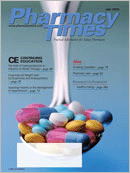Publication
Article
Pharmacy Times
A Pharmacist's Guide to OTC Therapy: OTC Treatments for Warts
Warts are common viral infections of the epidermis and mucous membranes. The cause of warts is the human papillomavirus. Warts typically are found on the hands but can appear on any skin surface. They affect ~7% to 10% of the population, and 24% of those cases are plantar warts.1 Although a number of nonprescription products are available for the self-treatment of warts, it is important for patients to understand the appropriate use of these products.
Treatment
The goals of treatment include the effective removal of warts without scarring, as well as preventing reoccurrence and spreading to other areas of the body or to another individual. Nonprescription products may contain topical salicylic acid, or they may be cryotherapy products that contain a combination of dimethyl ether and propane.
Salicylic Acid
Topical salicylic acid is recognized as the only medication that is safe and effective for the self-treatment of common or plantar warts. Salicylic acid preparations are available in a plaster/pad vehicle that contains salicylic acid (12%-40%); a collodion-like vehicle that contains 5% to 17% of salicylic acid; and a karaya gum-glycol vehicle that contains salicylic acid (15%). It is important for pharmacists to determine whether self-treatment is appropriate for the individual. Examples of exclusions for self-treatment of warts include painful plantar warts; warts on the face, fingernails, toenails, or genitalia; extensive warts on one area of the body; and any contraindications relevant to the use of salicylic acid.1
Cryotherapy
In 2002, the FDA approved a combination of dimethyl ether and propane, which allows people to utilize the principles of cryotherapy in their own homes. Because the use of these products involves the freezing of the affected skin tissue, individuals should be advised to adhere carefully to the directions for these products. Improper use could possibly cause damage to adjacent unaffected areas of the skin.
Conclusion
Because warts are contagious, patients should be advised to wash their hands before or after having direct contact with the wart, to prevent the spread of warts to other areas as well as to other individuals. In addition, individuals should be reminded to use a separate towel for drying the area where the wart is located to prevent further spread to other areas of the body. They also should be advised not to manipulate the wart in any way. If warts are present on the bottom of the foot, patients should make sure that the wart is covered if walking barefoot.
Pharmacists always should stress the importance of the proper use and duration of wart products in order for them to be completely effective. Perceptible results are typically seen within the first or second week of therapy, and then complete wart removal typically occurs within 4 to 12 weeks of therapy.
Patients also should be encouraged to seek the advice of their primary health care provider if the wart still remains after 12 weeks of therapy and if there are signs of redness, swelling, pain, or irritation. They should be informed to seek the advice of their primary care provider if the warts continue to recur.
Certain patient populations?which can include people with diabetes, those with peripheral vascular disease, those with immunodeficiency disorders, or those on immunosuppressive agents?never should attempt to utilize these OTC products unless directed to by a physician.1 Patients always should be advised to seek medical assistance if there is any uncertainty regarding the appropriateness of self-treatment.
Ms. Terrie is a clinical pharmacy writer based in Haymarket, Va.
For a list of references, send a stamped, self-addressed envelope to: References Department, Attn. A. Stahl, Pharmacy Times, 241 Forsgate Drive, Jamesburg, NJ 08831; or send an e-mail request to: [email protected].







